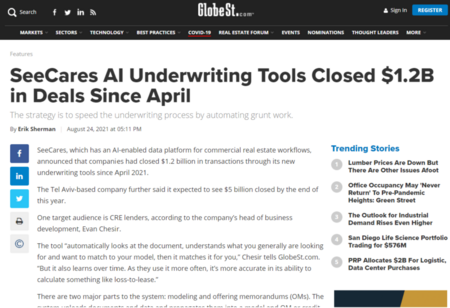
This article first appeared on GlobeSt.com, on August 24, 2021, written by Erik Sherman. Click here to view the original article at it’s source.
SeeCares, which has an AI-enabled data platform for commercial real estate workflows, announced that companies had closed $1.2 billion in transactions through its new underwriting tools since April 2021.
The Tel Aviv-based company further said it expected to see $5 billion closed by the end of this year.
As the deep tech product was developed, brokers began using the tool to generate offering-memorandums, and eventually lenders and borrowers got onboard using the platform to streamline their entire modeling, data-collection and memo-creation processes. As we continue expanding our core offering, the mission remains the same, helping CRE lenders and stakeholders to close and underwrite deals quickly and efficiently.
One target audience is CRE lenders, according to the company’s head of business development, Evan Chesir.
The tool “automatically looks at the document, understands what you generally are looking for and want to match to your model, then it matches it for you,” Chesir tells GlobeSt.com. “But it also learns over time. As they use it more often, it’s more accurate in its ability to calculate something like loss-to-lease.”
There are two major parts to the system: modeling and offering memorandums (OMs). The system uploads documents and data and propagates them into a model and OM or credit memo, automatically creating text for the latter two.
"We believe that 90% of the work can be eliminated, but there’s nothing like the analyst gut, especially in real estate...you still need analysts, but we believe SeeCares makes companies 80% more efficient. You don’t need as many analysts because you go through the deals more quickly."
“It takes a bit of [machine] learning to get the text right, but it’s instant,” Chesir says. “There’s no manual work that needs to go into it. This is a pain point for real estate investors and borrowers.”
Partnerships with third-party data suppliers like Cherre and real estate sites provide needed information without separate research and importing. “Our partnerships are based on the data sources already used in the industry,” says Chesir.
Underwriters can edit text and change parameters and assumptions in a model. The intent is not to eliminate the need for underwriters, as experienced human judgment remains critical. Rather, the tools are supposed to eliminate much of the data entry and other “grunt work” that analysts often must do.
“We believe that 90% of the work can be eliminated, but there’s nothing like the analyst gut, especially in real estate,” Chesir says. “You still need analysts, but we believe it makes companies 80% more efficient. You don’t need as many analysts because you go through the deals more quickly.”
By speeding the work of underwriting, lenders in theory could consider more deals and work more efficiently, increasing revenue as well as improving profitability.
The data processing, analysis, and workflow side of proptech has been busy, as it represents a weakness for many in the industry. JLL recently announced that it would acquire Skyline AI, which uses data and software algorithms to process data from 300 sources to support decision making.
